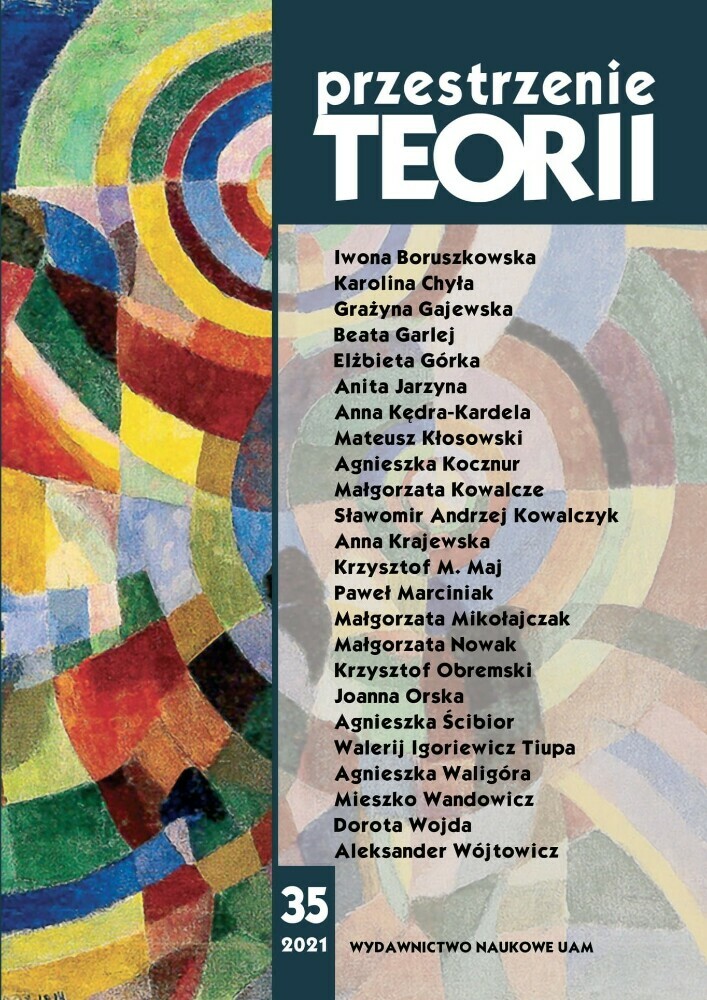Abstrakt
The paper applies selected devices of the methodology of Object-Oriented Ontology to study William Golding’s novel Free Fall. Particular attention is given to Graham Harman’s project, whose definition of an object accounts for all beings, humans included. Within the ontological structure of an object two components can be distinguished: the “sensual object”, which can engage in relationships with other objects, and the “real object”, which refrains from any connections. The author aims to show how the main protagonist of Golding’s novel is impacted on by material objects, how other humans are perceived by him as inherently dual beings, but most importantly how the protagonist himself discovers the thing-like quality of his own human condition.
Bibliografia
Babb H.S., The Novels of William Golding, The Ohio State University Press 1970.
Bal M., Narratologia: wprowadzenie do teorii narracji, Kraków 2012.
Brown B., Thing Theory, [w:] Things, red. B. Brown, Chicago–London 2004.
Crane J.K., Golding and Bergson: The Free Fall of Free Will, „The Bulletin of the Rocky Mountain Modern Language Association” 1972, vol. 26, no. 4, s. 136–141.
Domańska E., Humanistyka ekologiczna, „Teksty Drugie” 2013, nr 1–2.
Domańska E., Humanistyka nie-antropocentryczna a studia nad rzeczami, „Kultura Współczesna” 2008, nr 3 (57).
Elliott G.P., Three Imaginary Autobiographies A Kind of Fighting by Patrick Cruttwell; The Experience by Cecil Hemley, Free Fall by William Golding, „The Hudson Review” 1960, vol. 13, no. 2.
Gadamer H.-G., Tekst i interpretacja, przeł. P. Dehnel, [w:] H.-G. Gadamer, Język i rozumienie, wybór, przekł. i posł. P. Dehnel, B. Sierocka, Warszawa 2003, s. 99–141.
Gallagher M.P., The Human Image in William Golding, „An Irish Quarterly Review” 1965, no. 54, s. 197–216.
Golding W., Siłą bezwładu, tłum. M. Skibniewska, Poznań 1996.
Harman G., Object-Oriented Ontology: A New Theory of Everything, London 2018.
Harman G., On the Undermining of Objects: Grant, Bruno, and Radical Philosophy, [w:] The Speculative Turn: Continental Materialism and Realism, red. L. Bryant, G. Harman, N. Srnicek, Melbourne 2011.
Harman G., Tool-Being: Heidegger and the Metaphysics of Objects, Chicago 2002.
Harman G., Traktat o przedmiotach, tłum. M. Rychter, Warszawa 2013.
Kant I., Krytyka czystego rozumu, tłum. P. Chmielowski, <https://wolnelektury.pl/katalog/lektura/krytyka-czystego-rozumu.html> [dostęp: 15.08.2020].
Kimbell L., The Object Strikes Back: An interview with Graham Harman, „Design and Culture” 2013, 5 (1), s. 1–14.
Krajewski M., Są w życiu rzeczy… Szkice z socjologii przedmiotów, Warszawa 2013.
Levinas E., Całość i nieskończoność. Esej o zewnętrzności, tłum. A. Kowalska, Warszawa 2002.
Łebkowska A., Narracja, w: Kulturowa teoria literatury. Główne pojęcia i problemy, red. R. Nycz, M.P. Markowski, Kraków 2010.
Morton T., Hyperobjects. Philosophy and Ecology after the End of the World, Minneapolis–London 2013.
Plessner H., Władza a natura ludzka. Esej o antropologii światopoglądu historycznego, Warszawa 1994.
Sheldon R., Form/Matter/Chora: Object Oriented Ontology and Feminist New Materialism, [w:] The Nonhuman Turn, red. R. Grusin, Minneapolis 2015.
Straub J., A Victorian Muse. The Afterlife of Dante’s Beatrice in Nineteenth-Century Literature, London–New York 2009.
The Cambridge Companion to The Body in Literature, red. D. Hillman, U. Maude, New York 2015.
Zborowska A., Przedmioty w działaniu, „Widok. Teorie i praktyki kultury wizualnej” 2014, nr 6, <http://pismowidok.org/index.php/one/article/view/200/330> [dostęp: 21.09.2017].
Licencja
Autorzy
Autorzy tekstów przyjętych do publikacji w czasopiśmie „Przestrzeniach Teorii” są zobowiązani do wypełnienia, podpisania i odesłania na adres redakcji umowy o udzielenie nieodpłatnej licencji do utworów, z zobowiązaniem do udzielania sublicencji CC.
Zgodnie z umową, autorzy tekstów opublikowanych w czasopiśmie „Przestrzeniach Teorii” udzielają Uniwersytetowi im. Adama Mickiewicza w Poznaniu niewyłącznej i nieodpłatnej licencji oraz zezwalą na użycie sublicencji Creative Commons Attribution-NonCommercial-NoDerivatives 4.0 International (CC BY-NC-ND 4.0).
Autorzy zachowują prawa do dalszego, swobodnego rozporządzania utworem.
Autorzy, którzy wykorzystują w swoim tekście cudze utwory (np. ilustracje, fotografie) proszeni są o dostarczenie do redakcji czasopisma zgodę na publikację od uprawnionych podmiotów.
Użytkownicy
Zainteresowani użytkownicy internetu uprawnieni są do korzystania z utworów opublikowanych po 2015 roku „Przestrzeniach Teorii” tylko w calach niekomercyjnych, pod następującymi warunkami:
- uznanie autorstwa - obowiązek podania wraz z rozpowszechnionym utworem, informacji, o autorstwie, tytule, źródle (odnośniki do oryginalnego utworu, DOI) oraz samej licencji;
- bez tworzenia utworów zależnych - utwór musi być zachowany w oryginalnej postaci, nie można bez zgody twórcy rozpowszechniać np. tłumaczeń, opracowań.
Do wszystkich tekstów opublikowanych przed 2015 r. prawa autorskie są zastrzeżone.
Inne
Uniwersytet im. Adama Mickiewicza w Poznaniu zachowuje prawo do czasopisma jako całości (układ, forma graficzna, tytuł, projekt okładki, logo itp.).

